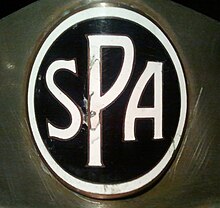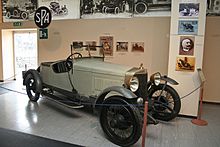This is an old revision of this page, as edited by Chienlit (talk | contribs) at 19:06, 16 April 2014 (→Aero engines: fix CANT 7). The present address (URL) is a permanent link to this revision, which may differ significantly from the current revision.
Revision as of 19:06, 16 April 2014 by Chienlit (talk | contribs) (→Aero engines: fix CANT 7)(diff) ← Previous revision | Latest revision (diff) | Newer revision → (diff) | |
| Industry | Automotive |
|---|---|
| Founded | 1906 |
| Defunct | 1926 |
| Fate | ceased production |
| Headquarters | Turin, Italy |
| Key people | Michele Ansaldi, Matteo Ceirano founders |
| Products | Automobiles |

S.P.A. (Società Piemontese Automobili), was an Italian automobile, military vehicle and aero-engine manufacturer founded in Turin by Matteo Ceirano and Michele Ansaldi. It was active between 1906 and 1926. In 1908, it merged with Fabbrica Ligure Automobili Genova (F.L.A.G.) and the new company, Società Ligure Piemontese Automobili, was head-quartered in Genoa while manufacturing in Turin.
In 1923 it moved to Turin and in 1925 was taken over by Fiat, whereby car manufacture ceased but commercial and military vehicle production continued. Although car production resumed after World War II, by 1947 the company was fully absorbed into Fiat.
Background
The Ceirano brothers, Giovani Battista, Ernesto and Matteo, were influential in the founding of the Italian auto industry, being variously responsible for : Ceirano; Welleyes (the basis of Fiat); SCAT (Società Ceirano Automobili Torino); Itala and S.P.A. (Società Piemontese Automobili).
In 1888, after eight years apprenticeship at his father's watch-making business, Giovanni Battista Ceirano started building Welleyes bicycles, so named because English names had more sales appeal. In October 1898 Giovanni co-founded Ceirano GB & C and started producing the Welleyes motor car in 1899. In July 1899 the plant and patents were sold to Giovanni Agnelli and produced as the first F.I.A.T.s. In 1904 Matteo Ceirano left Ceirano GB & C to create his own brand - Itala. In 1906 Matteo left Itala to found S.P.A. (Società Piemontese Automobili). In 1906 Giovanni founded SCAT (Società Ceirano Automobili Torino) in Turin.
History

The company was established in 1906 by Matteo Ceirano and Michele Ansaldi in Turin under the name of Società Piemontese Automobili. The chief designer was Alberto Ballacco.
In 1908, the company merged with Fabbrica Ligure Automobili Genova (FLAG) and the new company became Società Ligure Piemontese Automobili. The headquarters was in Genoa while production continued in Turin.
During World War 1 the company produced aero engines such as the 6A.
In 1916, both Ceirano and Ansaldi left.
In 1923 the company moved to Turin.
Financial problems lead to a take-over by Fiat in 1925 and the discontinuation of car manufacture in favour of commercial and military vehicles.
After World War II they resumed car production but in 1947 the company was fully absorbed into Fiat.
Cars

The first S.P.A.s designed by Alberto Ballacco and Ceirano were the 28/40HP and 60/70 HP which had four cylinder engines, side valves and live rear axles. They were exhibited at the Esposizione di Torino.
By 1907 they also produced two six-cylinder models, one of which had the flywheel mounted at the front of the crankshaft.
By 1901 they had introduced L-head monobloc engine designs, unitary gearboxes, and High tension magneto ignition systems.
In 1912 they sold 500 cars and introduced a new four cylinder 14/16hp engine as the basis of their modern, compact car.
By 1914 the range included twin, four and six cylinder cars - the biggest had an 11,536cc displacement.
After WW1 production resumed with the pre-war models; the 14/16 HP using a 2.700cc side-valve engine and the '25/30 HP using a 4,400cc six cylinder engine.
In 1922 the highly sophisticated 30/40 Super Sports was launched, with a 4,400cc six cylinder engine, using twin overhead camshafts (dohc) operating four valves per cylinder. The aluminium alloy cylinders had steel liners and aluminium pistons, plus dual carburettors and dual-ignition. The car was also equipped with front-wheel brakes and a V-shaped radiator.
By 1923 the sporting range was marketed as Tipo 23, Tipo 24 and Tipo 25.
Competition
In 1909 an S.P.A. racer driven by Francesco Ciuppa won the Targa Florio race. Completing a single lap of the 148km Grande Circuit in 2 hours 43 minutes 19 seconds at an average speed of 54.67 kph.
Range
- 28/40 HP
- 50 HP
- 60/70 HP
- 25/30 HP
- 14/16 HP
- Tipo 23
- Tipo 23 S
- Tipo 24
- Tipo 25
Aero engines

During World War I the company also produced aero engines. The S.P.A. 6A was a water-cooled inline six-cylinder engine that produced 220 horsepower (164 kW).
The SPA 6A was used to power: the Ansaldo A.1 Balilla - Italy's only domestically-produced fighter aircraft; the Ansaldo SVA - reconnaissance biplane; the Breda A.2 - a 1921 Italian sport and touring aircraft ; Breda A.3; Breda A.9 and A.9bis - a 1928 Italian biplane trainer for the Regia Aeronautica; the CANT 7 - a 1920 Italian Flying boat; and the Marchetti MVT/SIAI S.50 - a 1919-1920s Italian fighter aircraft.
Military vehicles
- SPA 9000 da 102/35 catturato dagli austriaci
- Dovunque 35
- Dovunque 35 protetto
- Dovunque 41
- 25C/10
- 36R
- 38R
- S37
- AS37
- AS42
- AS43
- CL39
- TL37
- TM40
- A-10000
See also
References
- Lancia, the essentials
- ^ The Complete History of the Motor Car by G.N. Georgano. Ebury Press 1973. pp 636
- History of Targa Florio
- History of Targa Florio - 1909
External links
- Società Piemontese Automobili unofficial site Template:It icon
- Unique Cars and Parts. Lost Marques: SPA - Societa Piemontese Automobili
- SPA Militare
| Fiat Chrysler Automobiles (2014–2021) | |||||||||||
|---|---|---|---|---|---|---|---|---|---|---|---|
| Predecessors | [REDACTED] | ||||||||||
| Successor | |||||||||||
| Marques | |||||||||||
| Subsidiaries |
| ||||||||||
| Facilities |
| ||||||||||
| People | |||||||||||